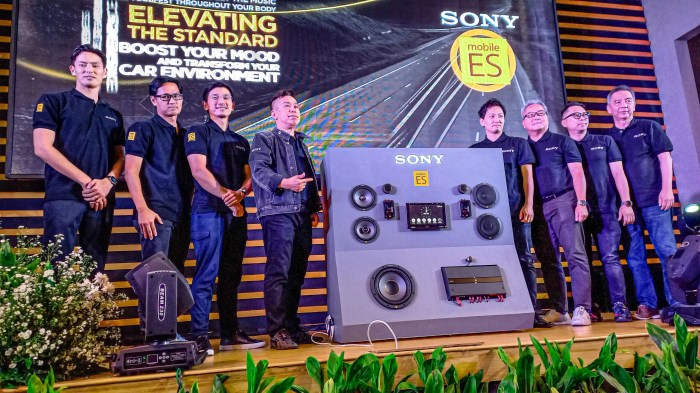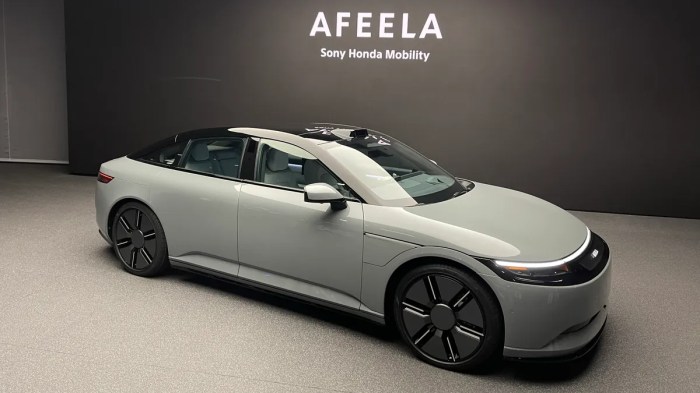Sony New Car Price A Market Analysis
Sony Vision-S: A Look at the Potential of a Sony Car: Sony New Car Price
Sony new car price – Sony’s foray into the automotive market with the Vision-S prototype has generated significant interest. This exploration delves into the vehicle’s features, potential pricing strategies, market analysis, manufacturing considerations, technological integration, and envisioned interior design, providing a comprehensive overview of what a Sony car might entail.
Sony Vision-S Vehicle Overview

Source: imagedelivery.net
The Sony Vision-S is a fully electric SUV prototype showcasing advanced technology and a sleek design. Its exterior features clean lines, a low profile, and a futuristic aesthetic. Inside, the cabin emphasizes minimalist design and a focus on technology integration. The vehicle boasts a powerful all-wheel-drive system and a suite of advanced driver-assistance systems (ADAS), including Level 2 autonomous driving capabilities.
While not directly competing with established automakers in terms of mass production, its technological advancements position it as a strong contender in the luxury EV segment. The Vision-S aims to differentiate itself through its sophisticated technology and seamless integration of entertainment features.
Vision-S Specifications Compared to Competitors
The following table compares the Vision-S’s specifications (based on available prototype data) to three comparable electric vehicles from established manufacturers. Note that final specifications for a production model may differ.
| Make | Model | Horsepower | Top Speed (mph) |
|---|---|---|---|
| Sony | Vision-S | ~540 (estimated) | ~149 (estimated) |
| Tesla | Model X Plaid | 1020 | 163 |
| Audi | e-tron GT | 469-590 | 152 |
| Rivian | R1S | 835 | 140 |
Potential Pricing Strategies for a Sony Car
Sony’s pricing strategy for a mass-market vehicle would need to balance its premium brand image with competitive market pricing. A tiered approach with various trim levels, offering different features and technological packages, is likely. This would allow Sony to target a wider range of consumers. Luxury brands often utilize prestige pricing, while mass-market brands focus on value pricing.
Sony might adopt a hybrid approach, leveraging its brand recognition to justify a slightly higher price point than comparable vehicles while offering competitive value propositions.
- Base Model: Estimated price: $45,000 – Features: Standard EV performance, basic driver-assistance systems, and essential interior amenities.
- Premium Model: Estimated price: $60,000 – Features: Enhanced performance, advanced driver-assistance systems, upgraded interior materials, and enhanced infotainment system.
- Signature Model: Estimated price: $80,000 – Features: Top-of-the-line performance, full suite of autonomous driving features, luxurious interior appointments, and exclusive technological features.
Market Analysis and Target Audience
Sony’s target audience would likely include tech-savvy individuals, early adopters of new technology, and consumers who value both performance and advanced features. Marketing strategies could leverage digital channels, partnerships with technology influencers, and collaborations with lifestyle brands. Sony’s strong brand recognition could positively influence consumer perception, associating the vehicle with quality, innovation, and a premium experience. However, it also faces challenges in establishing credibility in the automotive industry.
- Strengths: Strong brand recognition, technological expertise, potential for innovative features.
- Weaknesses: Lack of automotive manufacturing experience, potential higher production costs, reliance on partnerships.
- Opportunities: Growing demand for electric vehicles, potential for disruptive technologies, opportunity to establish a premium brand in the EV market.
- Threats: Intense competition from established automakers, potential supply chain disruptions, economic fluctuations impacting consumer spending.
Manufacturing and Production Considerations

Source: mobilesyrup.com
Establishing a vehicle manufacturing process presents significant challenges for Sony. This includes securing manufacturing facilities, managing complex supply chains, and ensuring quality control. Strategic partnerships with established automakers or contract manufacturers would be crucial. Logistical aspects such as parts sourcing, assembly, and distribution require careful planning and execution.
- Concept Development and Design (1-2 years)
- Prototype Development and Testing (1-2 years)
- Manufacturing Facility Establishment and Supply Chain Setup (1-2 years)
- Production Ramp-up and Pre-Production Testing (1 year)
- Market Launch (Ongoing)
Technological Integration and Features, Sony new car price
Sony’s expertise in entertainment and technology could significantly differentiate its vehicle. The integration of advanced audio systems, high-resolution displays, and intuitive user interfaces is expected. Features like augmented reality head-up displays, personalized infotainment profiles, and seamless smartphone integration would be key differentiators. Sony’s expertise in image sensors and processing could lead to superior driver-assistance systems and enhanced safety features.
The envisioned in-car entertainment system would feature a large, high-resolution central display, a customizable digital instrument cluster, and advanced audio with noise cancellation and spatial audio capabilities. The system would be seamlessly integrated with smartphone connectivity, offering access to streaming services, navigation, and communication features through a user-friendly interface. The system could also include features such as gaming capabilities and personalized entertainment profiles.
Illustrative Depiction of a Sony Vehicle Interior

Source: kinja-img.com
The interior would prioritize a minimalist yet luxurious design. High-quality materials such as sustainable leather or vegan alternatives, brushed aluminum accents, and ambient lighting would create a sophisticated atmosphere. The dashboard would feature a clean, uncluttered layout with a large central display dominating the center console. Controls would be intuitive and ergonomically designed, prioritizing ease of use and driver comfort.
The passenger experience would emphasize comfort, safety, and entertainment, with features like heated and ventilated seats, a panoramic sunroof, and a high-quality sound system.
While the price of a new Sony car (if such a vehicle existed) would undoubtedly be substantial, consider the ongoing maintenance costs. A significant portion of that would involve replacing worn tires, as you can see from checking the current prices at price of new tires for a car. Therefore, budgeting for tire replacements is crucial when assessing the overall cost of ownership, even for a hypothetical Sony vehicle.
FAQ Section
Will Sony manufacture the cars themselves, or outsource production?
Sony’s manufacturing approach remains unclear. They might partner with an established automaker for production or establish their own manufacturing facilities, each impacting the final price.
What is the expected release date for a Sony car?
A definitive release date is not yet available. The timeline depends on several factors, including securing manufacturing partnerships and finalizing the vehicle’s design and production processes.
What battery technology will Sony’s car use?
Details about the specific battery technology are not yet publicly available. However, given Sony’s technological expertise, we can anticipate a high-performance, potentially long-range battery solution.
Will Sony offer different powertrain options?
This remains uncertain. The initial Vision-S prototype was electric, but future models might offer various powertrain choices to cater to different market segments.




















